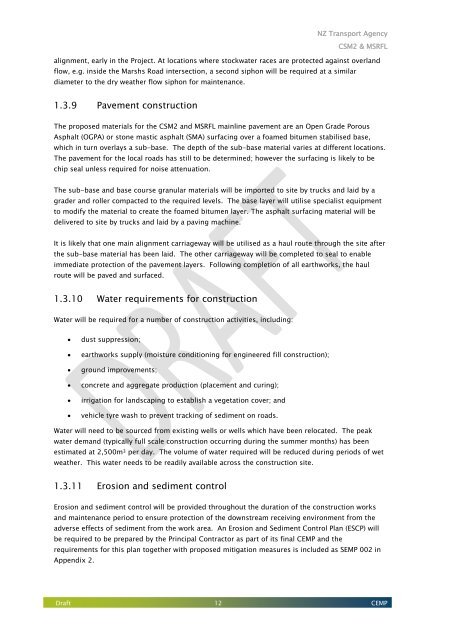CEMP - NZ Transport Agency
CEMP - NZ Transport Agency
CEMP - NZ Transport Agency
Create successful ePaper yourself
Turn your PDF publications into a flip-book with our unique Google optimized e-Paper software.
<strong>NZ</strong> <strong>Transport</strong> <strong>Agency</strong><br />
CSM2 & MSRFL<br />
alignment, early in the Project. At locations where stockwater races are protected against overland<br />
flow, e.g. inside the Marshs Road intersection, a second siphon will be required at a similar<br />
diameter to the dry weather flow siphon for maintenance.<br />
1.3.9 Pavement construction<br />
The proposed materials for the CSM2 and MSRFL mainline pavement are an Open Grade Porous<br />
Asphalt (OGPA) or stone mastic asphalt (SMA) surfacing over a foamed bitumen stabilised base,<br />
which in turn overlays a sub-base. The depth of the sub-base material varies at different locations.<br />
The pavement for the local roads has still to be determined; however the surfacing is likely to be<br />
chip seal unless required for noise attenuation.<br />
The sub-base and base course granular materials will be imported to site by trucks and laid by a<br />
grader and roller compacted to the required levels. The base layer will utilise specialist equipment<br />
to modify the material to create the foamed bitumen layer. The asphalt surfacing material will be<br />
delivered to site by trucks and laid by a paving machine.<br />
It is likely that one main alignment carriageway will be utilised as a haul route through the site after<br />
the sub-base material has been laid. The other carriageway will be completed to seal to enable<br />
immediate protection of the pavement layers. Following completion of all earthworks, the haul<br />
route will be paved and surfaced.<br />
1.3.10 Water requirements for construction<br />
Water will be required for a number of construction activities, including:<br />
• dust suppression;<br />
• earthworks supply (moisture conditioning for engineered fill construction);<br />
• ground improvements;<br />
• concrete and aggregate production (placement and curing);<br />
• irrigation for landscaping to establish a vegetation cover; and<br />
• vehicle tyre wash to prevent tracking of sediment on roads.<br />
Water will need to be sourced from existing wells or wells which have been relocated. The peak<br />
water demand (typically full scale construction occurring during the summer months) has been<br />
estimated at 2,500m 3 per day. The volume of water required will be reduced during periods of wet<br />
weather. This water needs to be readily available across the construction site.<br />
1.3.11 Erosion and sediment control<br />
Erosion and sediment control will be provided throughout the duration of the construction works<br />
and maintenance period to ensure protection of the downstream receiving environment from the<br />
adverse effects of sediment from the work area. An Erosion and Sediment Control Plan (ESCP) will<br />
be required to be prepared by the Principal Contractor as part of its final <strong>CEMP</strong> and the<br />
requirements for this plan together with proposed mitigation measures is included as SEMP 002 in<br />
Appendix 2.<br />
Draft 12 <strong>CEMP</strong>
















